|
|||||
FlyingRC.net is a
Veteran-Owned site.

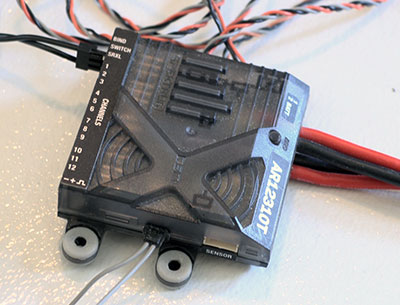 |
| The Spektrum™ AR12310T PowerSafe Receiver is worth every nickel in my planes. Plus, it has some interesting capabilities I will use down the road. Click image to enlarge |
Spektrum™ AR12310T PowerSafe Receiver
High-Tech safety and reliability with room to grow
Text, photos and video by Tom Hintz
Posted - 7-22-2019
Up Front
Some folks will question my continued use of the Spektrum Powersafe receivers after my Hangar 9 Valiant (30cc) was destroyed when an older version of the PowerSafe receiver failed. First, expecting anyone to make many thousands of anything perfectly all the time just isn’t reasonable. Everyone is going to have a dud occasionally. In the case of the failed Powersafe receiver it was old, had been in several planes and had the snot flown out of it for years. I continue using PowerSafe receivers, in all my giant scale planes and will continue to do so because I like and trust them. And no, Spektrum is not paying me to say that. In fact, I have as much difficulty as anyone getting a real answer to questions that goes beyond a copy/paste from the product manual. The aluminum foil in the hat crowd will have to come up with a different conspiracy.
I have been a believer in the Spektrum Powersafe line of receivers a long time so when outfitting my 3D Hobby Shop 75" Edge 540, I chose the Spektrum™ AR12310T PowerSafe Receiver. Matched with my Spektrum iX12 transmitter this combination opens the door to future Reviews of Spektrum’s telemetry modules as well as the compatible AS3000 AS3X Flight Stabilization Module (#SPMAS3000). The full list of features and capabilities packed into the Spektrum™ AR12310T PowerSafe Receiver exceed my current needs but like many of you, provides me with room, and incentive to grow.
The Basics
The Spektrum™ AR12310T PowerSafe Receiver features 12 channels and integrated full-range telemetry. It accepts receiver battery power from 3.5V to 10V making it compatible with high-voltage, high-power servos. Dedicated telemetry ports are provided for RPM, receiver battery voltage and temperature sensors. It also has an X-Bus port for more telemetry options. The receiver pack voltage telemetry monitor is especially handy for those of us that like to squeeze another flight or two in a day.
At 55.94mm-wide by 55mm-long and 17.73mm tall the Spektrum™ AR12310T PowerSafe Receiver is a bit larger than previous models. Weighing just 48.19g, it is not likely to throw your CG out of whack.
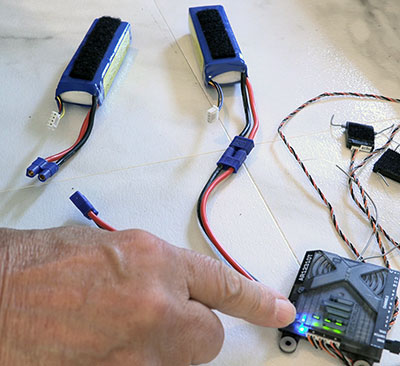 |
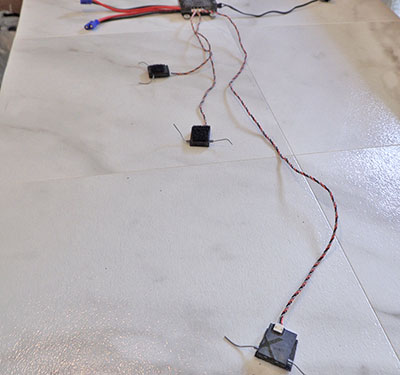 |
| The dual battery leads (left) have lights at their base that when lit, indicate a bad pack. Three satellite receivers (right) are included on different length cables to get the best spread and maximum reception. Click images to enlarge |
|
Built-in rubber mounting grommets simplify installation by isolating the Spektrum™ AR12310T PowerSafe Receiver from fuselage vibrations without having to add foam rubber and strapping. Screw the Spektrum™ AR12310T PowerSafe Receiver to a flat surface and mounting is done.
Though a bind plug port is provided Spektrum incorporates an external Bind button on the receiver case. Some operations call for using the traditional bind plug but even that access is simplified when the Spektrum™ AR12310T PowerSafe Receiver is installed.
The Spektrum™ AR12310T PowerSafe Receiver comes with 3 remote receivers on different length cables to make spreading them out in a fuselage easier. The built-in Spektrum MultiLink™ (patented) technology helps eliminate reflected signal fading and antenna blind spots that can occur even with 2.4GHz systems.
The Spektrum™ AR12310T PowerSafe Receiver has satellite ports labeled “B” (back), “L (left) and “R” (right). I don’t know if it matters which satellite receiver is plugged in where, but I follow the markings when placing them in my planes just in case. I figure they labeled those sockets for a reason.
The Power Safe in PowerSafe
The original reason for putting PowerSafe receivers in my planes is the true redundancy in the receiver battery packs. The days of using two packs, two switches and hoping one pack going bad doesn’t kill the other are over, thankfully. The Spektrum™ AR12310T PowerSafe Receiver has dual 13 AWG battery leads (w/ EC3 connectors) that keep the battery packs separated so if one has a problem the other takes over without a “brown-out” or other noticeable problem. This power system is especially helpful in planes with big, hi torque servos that can place a large draw on the power system. The Spektrum™ AR12310T PowerSafe Receiver is designed to handle that load and more.
When one battery fails the switch to the other one is so clean you likely would not notice it. The Spektrum™ AR12310T PowerSafe Receiver has lights at the base of the battery cables that indicate which pack went bad. I always turn the plane on before flying for the day and once after flying is done to see if one of those pack indicator lights is on.
The Spektrum™ AR12310T PowerSafe Receiver comes with a “soft switch”, called that because it can only fail to the On position. You can unplug the switch from the receiver and all that happens is the receiver turns on if it was Off or stays On if it was On before pulling the switch from the receiver. The only way to turn the Spektrum™ AR12310T PowerSafe Receiver off with out the switch is to disconnect both battery packs.
Telemetry
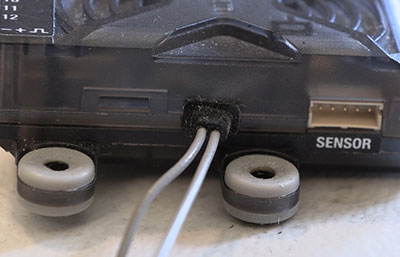 |
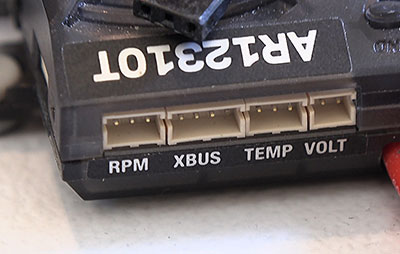 |
| The new mounting tabs (left) are a great addition that makes installing this receiver fast and secure. The telemetry ports (right) give us lots of options to explore later if not sooner. Click images to enlarge |
|
While I am not (yet) a devout telemetry user, the Spektrum™ AR12310T PowerSafe Receiver is helping lure me into that world by being surprisingly automatic when paired with my Spektrum iX12 transmitter. To get my feet wet I am using the built-in receiver pack mAh usage monitor so I can brag in real time how much power I have left in my traditional twin 5000mAh LiPo packs at the field. Nobody really listens but sometimes even a little self-induced ego boost is gratifying.
Being able to plug in several off-the-shelf telemetry sensors gives the Spektrum™ AR12310T PowerSafe Receiver the flexibility to adapt to the needs of a specialized airframe or your favorite sport flier.
Easy Servo Connectivity
One of the things I really like about the new Spektrum™ AR12310T PowerSafe Receiver (and all the new PowerSafe receivers) is the row of plug sockets where servos are connected. I know it could just be me, but previous receivers seemed to have virtually no extra room where the servos plugged in, often making them difficult to get aligned, inserted and then seated. The Spektrum™ AR12310T PowerSafe Receiver appears to have a just a tad of clearance that makes getting the servos plugged in easier. Despite the new fit, through everything I can throw at them (or the plane into/through) I have yet to find any of these plugs loose, moved or anything but still secure.
Conclusions
Most RC pilots favor various components at least in part because of their reliability to insure the survival of our often-expensive planes. That is precisely why all my larger planes have PowerSafe receivers in them. I trust them, I like the simplicity of installing and setting them up and their “behind the scenes” performance in the air. The Spektrum™ AR12310T PowerSafe Receiver delivers the capabilities I need now and the room to grow down the road.
The Spektrum™ AR12310T PowerSafe Receiver cost me $199.99 (7-10-2019) and while that is not cheap, I like the safety it affords my planes and its simplicity. I know it is going to work if I keep decent batteries hooked up to it and there are other, more pressing things to worry about, like missing the ground and stuff like that.
Video Tour |
If you use Spektrum radios and are building an intermediate to large plane, the Spektrum™ AR12310T PowerSafe Receiver should be at the top of your must-see list. This is a durable, highly capable line of receivers that can grow with your needs.
Have a comment on this Review? –Email Me
All Flyingrc.net written, photographic and drawn materials are property of and copyright by Tom Hintz and Flyingrc.net 2013-2020 Materials cannot be used in any way without the prior written permission of the owner.
Privacy Statement


